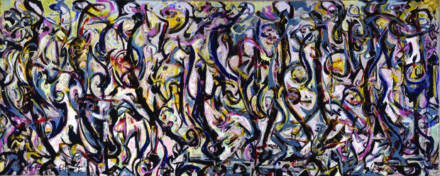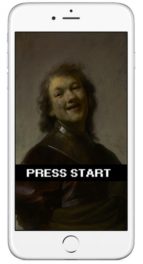Best known for his solemn religious paintings, Andrea del Sarto—the focus of the exhibition closing soon at the Getty and opening at The Frick Collection this fall—is indisputably one of the great artists of the sixteenth century. But to those new to his art, especially someone not into Christian art, a lineup of his many technically flawless and faith-bolstering altarpieces might give the impression that his art won’t exactly get your blood pumping.
But not so fast! Though his oeuvre is dominated by serious religious works (often painted for important, powerful patrons, mind you), there are moments that will thrill even the most skeptical viewers. The sober apostles, clothed from head to foot, in Andrea’s paintings were born in his studio as muscular male models posing in their underwear.

This figure of a saint was based on a preparatory sketch. Left: Assumption of the Virgin (detail), Andrea del Sarto. Oil on wood. Galleria Palatina (Palazzo Pitti), Florence. Source. Right: Study of a Kneeling Figure with a Sketch of a Face, 1522–26, Andrea del Sarto. Red and black chalk. The J. Paul Getty Museum, 84.GB.7
This was absolutely conventional in the Renaissance; a prescribed process of drawing, and thereby understanding, the body in its pose before covering it with clothing in a painting.
Andrea’s studio was full of ready models. His workshop assistants—called garzoni—played saints and other characters for him, and he seems to have had a sense of humor about these guys offering him their legs, torsos, heads, and so forth. In one drawing studying an arm for a Last Supper, he included a crude and comical, let’s say, swelling at the model’s groin. (The drawing can be seen in the exhibition).
St. John the Baptist, whose torso recalls Florence’s most famous torso, is perhaps Andrea’s most sensual religious painting. Scratch that: his most sensual painting. The depiction of the beautiful and almost uncomfortably young man could pass for a racy bedroom portrait if not for the attributes identifying him as the Baptist: cross, bowl, scroll, camel skin. Not surprisingly, it was commissioned for display in the home of a Florentine banker, not for a house of worship. The related head study (below) suggests an exquisite Florentine boy posed for him in his studio.

Saint John the Baptist, about 1523, Andrea del Sarto. Oil on panel, 37 x 26 3/4 in. Istituti museali della Soprintendenza Speciale per il Polo Museale Fiorentino. Su concessione del Ministero dei beni e delle attività culturali e del turismo

Study for the Head of Saint John the Baptist, about 1523, Andrea del Sarto. Black chalk, 13 x 9 1/8 in. National Gallery of Art, Washington, Woodner Collection, 1991.182.14. Courtesy National Gallery of Art, Washington
Compare these with a contemporaneous sculpture at the Frick by Francesco da Sangallo, who chose to present St. John as an aged man, an ascetic showing signs of John’s hard time spent in a desert. Andrea offers us instead a virile boy on the cusp of becoming a man.

St. John Baptizing, ca. 1535–38, Francesco da Sangallo. Bronze, 20 7/8 in. high. The Frick Collection, New York. Henry Clay Frick Bequest. 1916.2.41
Andrea’s Baptist stirs something in people—standing in front of this captivating painting, they can’t seem to get enough of it. But the picture represents much more than indulgence in good looks. Renaissance artists rendered sacred bodies beautiful and erotic for several reasons.
Here is one: in Neoplatonic philosophy (which Michelangelo was particularly into and which infused Renaissance culture in general), the beautiful soul is expressed though a beautiful body.
Here is another: in Renaissance Christianity, Christ’s humanity, and thus sexuality, was as important as his divinity.
And another: emphasis on a sacred figure’s physical beauty directly connects to the passion and carnal desire embedded in religious stories, bible passages, and hagiographies. In a secular twenty-first-century culture, sacred subjects can seem distant, flat, and boring. But they certainly were not in the Renaissance—and especially not the story of John the Baptist, the patron saint of Florence and one of the most popular saints in Renaissance art.
John was at the center of a scandalous plot that ended with his beheading. The story is well known. John had criticized King Herod for marrying Herodias, his brother’s wife. Feeling scorned, Herodias sought revenge. At a feast hosted by the king, Herodias’s daughter Salomé, step-daughter/niece of the king, performed a dance (known popularly as the Dance of the Seven Veils and the inspiration for centuries of art and performances with various levels of erotic flair) that pleased Herod so much that he promised to grant her anything she wished. At her mother’s advice, Salomé asked for the head of John the Baptist on a platter, and it was done. In light of this story, the head study mentioned above takes on a darker note.
Andrea del Sarto celebrates the flesh and blood of his sacred characters and of his models. It follows that his drawings and paintings, as is the case for most great art, are also best experienced “in the flesh.”
Andrea says goodbye to the Getty shortly. Say hello at the Frick.
_______
Andrea del Sarto: The Renaissance Workshop in Action is on view at the Getty until September 13 and opens at The Frick Collection on October 7, 2015.




Well, Renaissance art itself not sure – but the branch of it roughly called “Mannerism” is an exasperation of High Renaissance and therefore yes – it can be extremely sensual. That is why at some point there was a council of Trent. If you were wondering – this is a religious depiction of “charity” in the Palazzo Barberini in Rome! http://www.beniculturali.it/mibac/multimedia/MiBAC/images/med/31/6d56addd7fa5151b13e6cb9f095f125157270ea.jpg
Aimee Ng’s “Andrea del Sarto’s Seductive Saints” is a fine little essay, full of interesting observations and insights. Regarding the Neoplatonic thought that “the beautiful soul is expressed [through] a beautiful body,” however, let’s not forget the principal role of the face, as suggested by the wonderful ‘Study for the Head of Saint John the Baptist,’ and especially by the eyes in the painting itself. – Louis Torres, Co-Editor, Aristos (An Online Review of the Arts)